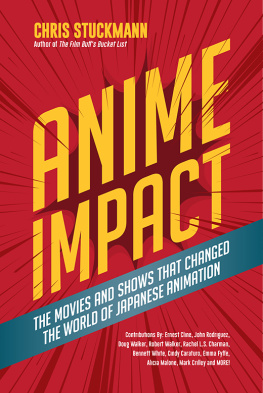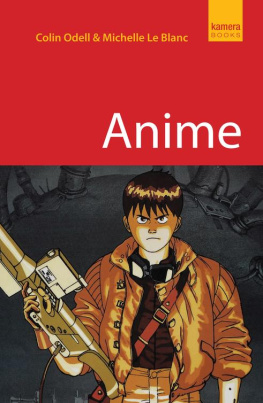Thomas Lamarre - The Anime Ecology: A Genealogy of Television, Animation, and Game Media
Here you can read online Thomas Lamarre - The Anime Ecology: A Genealogy of Television, Animation, and Game Media full text of the book (entire story) in english for free. Download pdf and epub, get meaning, cover and reviews about this ebook. year: 2018, publisher: University of Minnesota Press, genre: Art. Description of the work, (preface) as well as reviews are available. Best literature library LitArk.com created for fans of good reading and offers a wide selection of genres:
Romance novel
Science fiction
Adventure
Detective
Science
History
Home and family
Prose
Art
Politics
Computer
Non-fiction
Religion
Business
Children
Humor
Choose a favorite category and find really read worthwhile books. Enjoy immersion in the world of imagination, feel the emotions of the characters or learn something new for yourself, make an fascinating discovery.

- Book:The Anime Ecology: A Genealogy of Television, Animation, and Game Media
- Author:
- Publisher:University of Minnesota Press
- Genre:
- Year:2018
- Rating:3 / 5
- Favourites:Add to favourites
- Your mark:
- 60
- 1
- 2
- 3
- 4
- 5
The Anime Ecology: A Genealogy of Television, Animation, and Game Media: summary, description and annotation
We offer to read an annotation, description, summary or preface (depends on what the author of the book "The Anime Ecology: A Genealogy of Television, Animation, and Game Media" wrote himself). If you haven't found the necessary information about the book — write in the comments, we will try to find it.
Thomas Lamarre: author's other books
Who wrote The Anime Ecology: A Genealogy of Television, Animation, and Game Media? Find out the surname, the name of the author of the book and a list of all author's works by series.
The Anime Ecology: A Genealogy of Television, Animation, and Game Media — read online for free the complete book (whole text) full work
Below is the text of the book, divided by pages. System saving the place of the last page read, allows you to conveniently read the book "The Anime Ecology: A Genealogy of Television, Animation, and Game Media" online for free, without having to search again every time where you left off. Put a bookmark, and you can go to the page where you finished reading at any time.
Font size:
Interval:
Bookmark:
Thomas Lamarre

University of Minnesota Press
Minneapolis | London
Copyright 2018 by Thomas Lamarre
All rights reserved. No part of this publication may be reproduced, stored in a retrieval system, or transmitted, in any form or by any means, electronic, mechanical, photocopying, recording, or otherwise, without the prior written permission of the publisher.
Published by the University of Minnesota Press
111 Third Avenue South, Suite 290
Minneapolis, MN 554012520
http://www.upress.umn.edu
The University of Minnesota is an equal-opportunity educator and employer.
Library of Congress Cataloging-in-Publication Data
Names: LaMarre, Thomas, author.
Title: The anime ecology : a genealogy of television, animation, and game media / Thomas Lamarre.
Description: Minneapolis : University of Minnesota Press, 2018. | Includes bibliographical references and index.
Identifiers: LCCN 2017042800 | ISBN 978-1-4529-5694-7
Subjects: LCSH: Animated filmsJapanHistory and criticism. | Television programsSocial aspects. | Video gamesSocial aspects. | Cultural industriesSocial aspects. | BISAC: PERFORMING ARTS / Animation. | SOCIAL SCIENCE / Popular Culture.
Classification: LCC NC1766.J3 L34 2018 | DDC 791.43/340952dc23
LC record available at https://lccn.loc.gov/2017042800
This book explores the relation between television and animation. It deals with how television affects animation, and how animation allows for a different perspective on television media, one more in keeping with the contemporary situation in which what has traditionally been designated as television is now thoroughly mixed with a host of other media and media practices. Such an exploration is necessarily broad in reach and synthetic in impulse. It draws on research conducted in a number of disciplines, including cognitive science, neuroscience, economic and sociological studies of telecommunications, infrastructure studies, as well as in the vast middle ground of cultural studies, film and media studies, and critical theory and philosophy, not to mention the field of Japanese studies.
In this Introduction, I wish to provide an overview of and guidelines to my approach to the key concern of this study: how the relation between television and animation hinges on infrastructures, multimedia franchises, and media ecologies. The result is a far-reaching introduction to a capacious and synthetic study. Yet I feel such an introduction is both necessary and desirable in order to situate my approach and findings in the context of contemporary debates within television, film, and media studies. I thus provide here an overview of some of the current questions about what is happening with television today and what is happening with animation, infrastructures, and multimedia franchises. This Introduction addresses what is happening concretely and pragmatically with television out there, and what is happening conceptually or speculatively within our interpretations of television. The speculative in here follows from the pragmatic out there: interpretation tracks, follows on, and hovers over concrete changes in practices, discourses, and technologies of the production, distribution, and consumption of television and animation. As such, I tend to situate myself more as a tracker and gatherer than as a keeper of fields or a builder of monuments. But televisions appeal, despite its thoroughly sedentary tendencies and statist legacies, may not ultimately lie in its association with settled worlds or monumental histories but rather in its calling for other kinds of society.
Somethings happening with television. TV industries around the world are producing record numbers of new shows, and these programs are finding their way into new markets via streaming services, cable and satellite services, and downloads, both in regular and informal economies. What is more, although there are pronounced generational differences, surveys tell us that people of all ages are watching as much or more television than ever. Still, it is equally plausible in response to such surveys to declare, as a young friend did, How is that even possible? No one I know even has a television!
The sense of whats happening to television depends on what your image of television ismedia platform (the television set), mode of reception or cultural practice (domestic versus ambient viewing), content (specific patterns of serialization), communications infrastructure (broadcast, cable, streaming), globalized experience of synchronicity, a bid for national or global unification based on demographic segmentation of content, or some combination of these modalities.
The first wager of this book is that whats happening with television today is a continuation of whats been happening with it for a long time. Interestingly, accounts of posttelevision in the North Atlantic region usually make reference to the rise of transmedia storytelling. In the context of Japanese television, however, transmedia storytelling is nothing new. It meshes with all periods of television. Japanese scholars thus tend to speak in terms of periods and generations of transmedia storytelling, or media mix, and to address transformations in it There is buzz in Japan, too, about TV that is not TV as a result of its medium and platform. A Nippon Telegraph and Telephone Company (NTT) service launched in 2013 bears the provocative name NOTTV (nottv) yet delivers television programming such as news and sports to smartphones. This not-TV form does not break with broadcast television; in fact, it is promoted as Japans first smartphone-oriented broadcaster. As such, NOTTV builds on a deeper history of the unbundling of TV from medium and platform that was hotly debated in 1980s Japan under the rubric of new media (see chapter 7). For these reasons, I do not adopt the rubric of posttelevision. Japanese television, which remains the worlds second largest industry, affords a different historical perspective on transformations in television media, platforms, and infrastructures. The rubric of posttelevision runs the risk of erasing the sociohistorical and geopolitical dimensions of contemporary television formations by introducing a globally synchronized break.
Recent developments in information technologies and telecommunications infrastructures have profoundly affected television modalities. Yet they have not resulted in a definitive rupture with prior modalities. In fact, I would like to up the ante here: thinking of television history in terms of rupture merely tends to sensationalize certain kinds of practices in certain parts of the world at certain times, fragmenting and detotalizing television only to retotalize its world preemptively, even if unwittingly. Presenting Japan as always already posttelevision, or as entering into a postposttelevision era, simply posits North Atlantic history as a normative point of reference, with Japan alongside the master. This is why this study, in its historical dimension, takes the form of genealogy: both continuity and discontinuity are evident at the level of television platforms, content, and infrastructures, which is also to say modes of reception, transmission, production, and serialization. What is deemed television at any one moment is an assembling of these modes.
One might also take another step back, as Siegfried Zielinski does, and consider television as an entracte in a deeper history of audiovision, which is to say, as one assembling of modalities in an even larger history of audiovisual media.is on genealogical transitions between one assembling of television and another. The overall emphasis falls on a particular lineage, in which domestic television practices centered on the family TV set were gradually expanded into the home media network in two registers: at the same time that game consoles and VHS, LD, VCD, DVD, and DVR devices were being plugged into the TV, new infrastructures of distribution (closed-circuit television, cable, satellite) were altering broadcast infrastructures.
Font size:
Interval:
Bookmark:
Similar books «The Anime Ecology: A Genealogy of Television, Animation, and Game Media»
Look at similar books to The Anime Ecology: A Genealogy of Television, Animation, and Game Media. We have selected literature similar in name and meaning in the hope of providing readers with more options to find new, interesting, not yet read works.
Discussion, reviews of the book The Anime Ecology: A Genealogy of Television, Animation, and Game Media and just readers' own opinions. Leave your comments, write what you think about the work, its meaning or the main characters. Specify what exactly you liked and what you didn't like, and why you think so.









